Looking for Popular African street foods you can enjoy when visiting Africa? Well, you’ve come to the right place!
From its awe-inspiring landscapes to its dynamic people, there is one aspect of Africa that truly captures the heart and spirit of every tourist that has ever stepped foot on this beautiful continent: its food.
African Street food, in particular, is the lifeblood of African culinary traditions. As you meander through the bustling streets of any African city or town, you’re welcomed by an array of tantalizing aromas and sights.
Steaming pots, sizzling grills, and colorful stalls dot the streets, each with vendors displaying their edible artworks. This is where the magic happens—where age-old recipes passed down through generations meet the hustle and bustle of urban life.
In Africa, we don’t just eat to live; we live to eat! Every bite tells a story, every flavor sings a tune, and every meal is a celebration. It’s more than just sustenance; it’s an immersive sensory experience and a love language spoken across the continent.
There are so many delicious and popular African street foods that it’s almost impossible to list them; however, here are our top 7 picks from all the regions in Africa that you should try out.
Table of Contents
Bunny Chow – South Africa (Southern Africa)

Another popular African street foods is Bunny Chow, which is fondly known as a ‘Bunny’ Bunny Chow is a classic South African dish with an intriguing story that reflects the diverse culture of this Rainbow Nation. Its roots trace back to the vibrant Indian community in Durban, where it was created as a convenient and portable meal for Indian laborers working in the sugar cane plantations.
The genius behind Bunny Chow lies in its simplistic yet flavorful design – a hollowed-out loaf of bread filled to the brim with robust, aromatic curry. Imagine dipping a chunk of soft, fresh bread into the hearty curry; with each bite offering a blissful harmony of spicy warmth and comforting carbs.
Traditionally, Bunny Chow is made with mutton curry, which is slow-cooked until the meat falls apart at the slightest touch. The gravy is a flavorful medley of spices – coriander, cumin, garam masala, and turmeric – infusing the dish with an irresistible aroma and deep flavors.
However, modern variations of the dish have expanded to include chicken, beans, or a host of vegetarian options, ensuring there is a Bunny to suit every palate.
Jollof Rice – Nigeria/Ghana (West Africa)
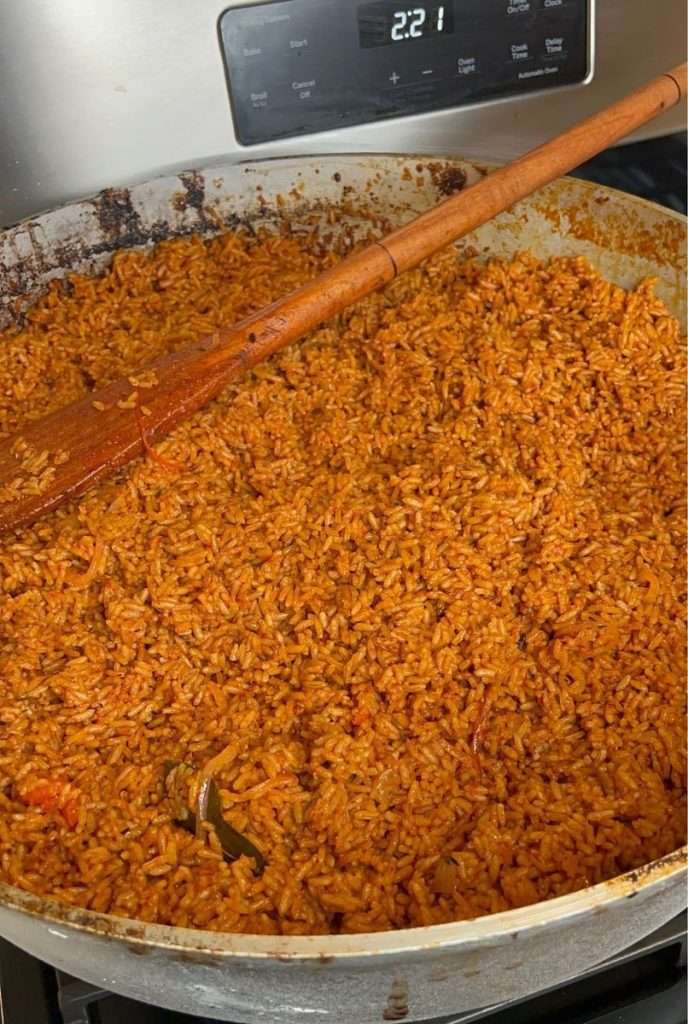
Though its precise origin is a topic of friendly contention amongst West Africans (especially the Nigerians and the Ghanaians), Jollof Rice is widely enjoyed in Nigeria and Ghana, with each country boasting its own unique interpretation of the dish.
The Nigerian version of Jollof Rice often uses long-grain parboiled rice, tomatoes, and a generous portion of Vegetable cooking oil that gives it its distinctively smoky taste. It’s frequently adorned with strips of fried plantains, fried meats, or fried chicken or turkey.
On the other hand, Ghanaian Jollof Rice, prepared with basmati or jasmine rice, leans towards a slightly spicier palette. It’s a fiery delight with the infusion of Scotch bonnet peppers, and garnishes can range from mixed vegetables to a variety of meats and even fish.
Each spoonful of Jollof Rice offers a burst of intense flavors: the sweetness of the caramelized onions, the tanginess of the tomatoes, and the heady scent of spices. Its fiery red-orange hue, achieved through the careful stewing of ingredients, is not just visually appealing but also indicative of its rich taste.
Doro Wat – Ethiopia (Eastern Africa)
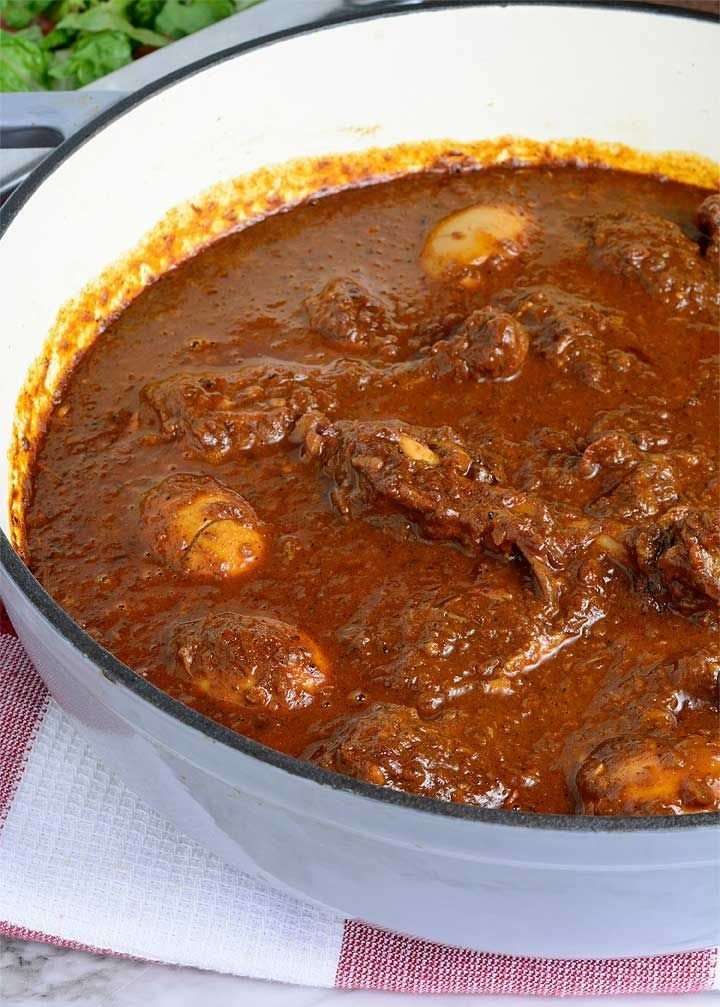
Another popular African Street foods is Doro Wat, which translates to “chicken stew” Doro Wat is a dish that resonates deeply with Ethiopians’ gastronomic heritage. Its distinctive flavor profile is as unique as the country it originates from.
Prepared with a harmonious blend of native spices, the stew’s depth of flavor is something that you will remember long after the last morsel is gone.
The cornerstone of Doro Wat is its slow-cooked sauce, a thick, fiery red gravy called ‘berbere’. Berbere is a signature Ethiopian spice mix that contains a combination of chili peppers, garlic, ginger, fenugreek, and a plethora of other herbs and spices.
The intense heat of the chili is beautifully balanced with the fragrant and earthy notes of the spices, creating a tantalizing taste experience. Traditionally, Doro Wat is made with chicken and hard-boiled eggs. The chicken, slow-cooked until tender, absorbs the flavor of the berbere, while the eggs, immersed in the stew, add a creamy contrast to the fiery sauce.
What sets Doro Wat apart is not just its robust flavor but also its mode of consumption. This dish is typically served atop Injera, a sourdough flatbread that’s a staple in Ethiopian cuisine.
The Injera acts as an edible spoon, used to scoop up the Doro Wat, creating a perfect marriage of flavors and textures.
Chapati and Rolex – Uganda (Eastern Africa)
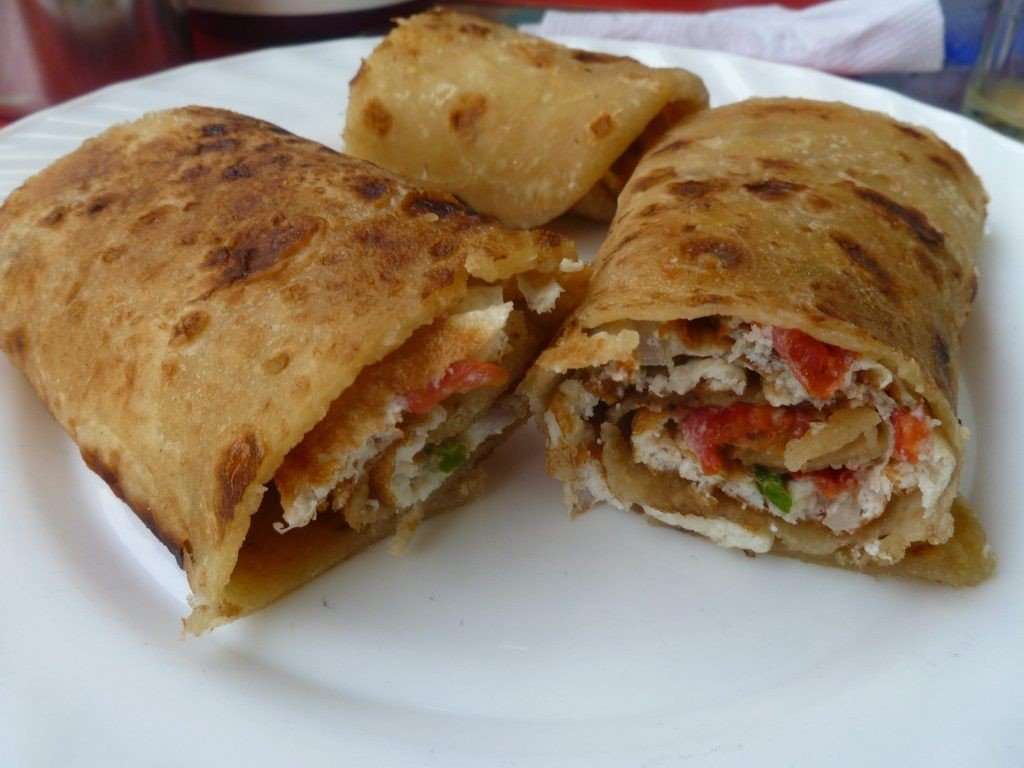
For the uninitiated, Rolex in this context is not related to the luxury watch brand. It’s a playful moniker derived from the phrase “roll of eggs,” indicative of the dish’s key components – a rolled chapati stuffed with an omelette.
A captivating spectacle to watch being prepared, this dish is a perfect example of how simple ingredients can be transformed into something profoundly delicious. The preparation of a Rolex begins with the making of chapati, an unleavened flatbread. The dough is rolled into a thin disc, then cooked on a hot griddle until golden brown and flaky.
Parallelly, a vibrant omelette is whipped up, typically featuring fresh tomatoes, cabbage, onions, and peppers. The cooked omelette is then meticulously wrapped within the chapati, forming the Rolex.
But the Rolex isn’t just a snack; it’s an embodiment of Uganda’s street food culture. It’s fast, it’s filling, and it’s fantastically flavorful.
The flaky, slightly crisp chapati provides a delightful contrast to the soft, veggie-filled omelette, making every bite a medley of textures and flavors.
Zanzibari Pizza – (Eastern Africa)
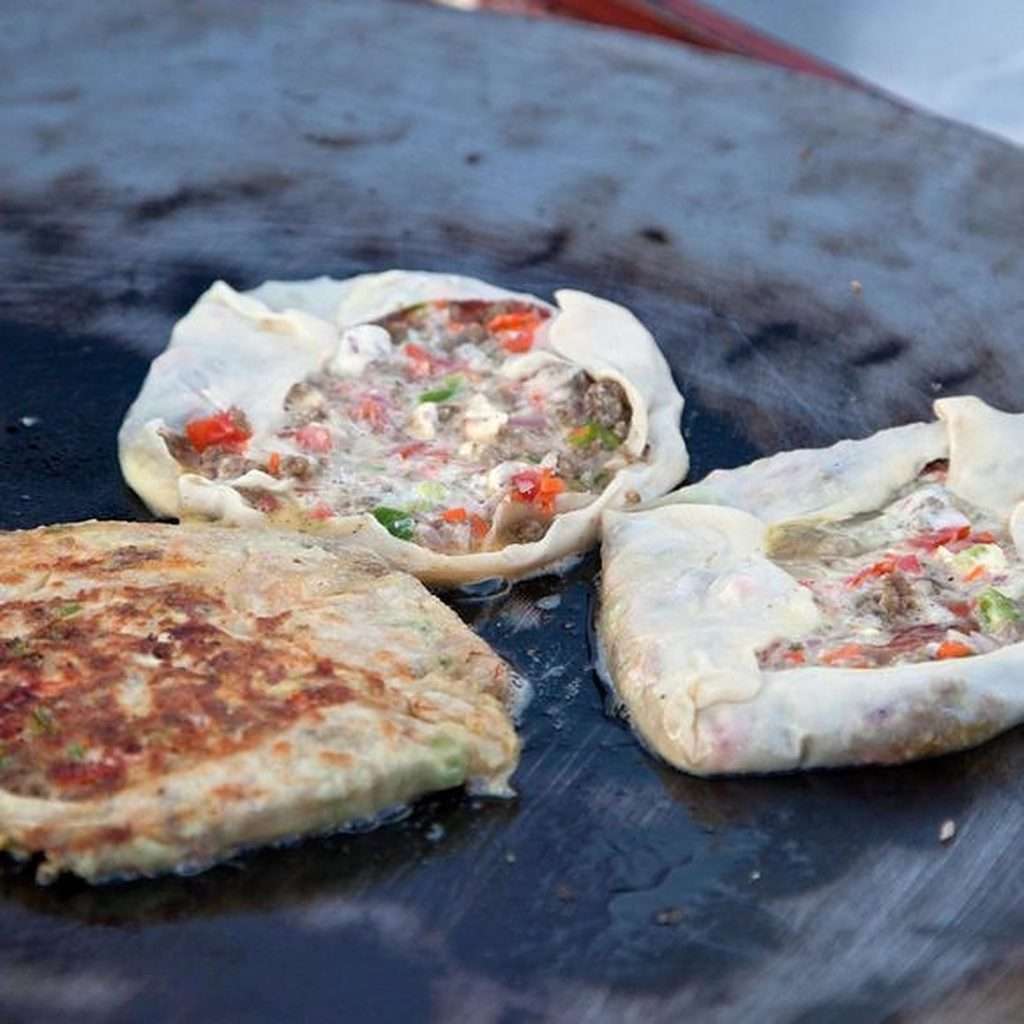
Unlike a traditional pizza, a Zanzibari Pizza is more akin to a stuffed pancake or crepe, filled with a myriad of ingredients. The magic begins with a thin, stretchy dough, which is skillfully spun, then filled with a mixture that typically includes minced meat, onions, peppers, and a beaten egg.
The dough is then folded into a square, encapsulating the filling, and shallow-fried to perfection on a griddle.
This African street food delight can be savored in both sweet and savory versions. While the savory variant often contains meat or seafood, the sweet version is usually filled with banana or mango, and sometimes even Nutella, offering a sublime dessert option for the sweet-toothed traveler.
The crispy exterior of the Zanzibari Pizza yields to a soft, savory filling, creating a captivating interplay of textures. It’s a dish that sings of Zanzibar’s culinary heritage, blending simplicity with sophistication, and offering a street food experience that is unforgettable.
Suya – Nigeria (West Africa)
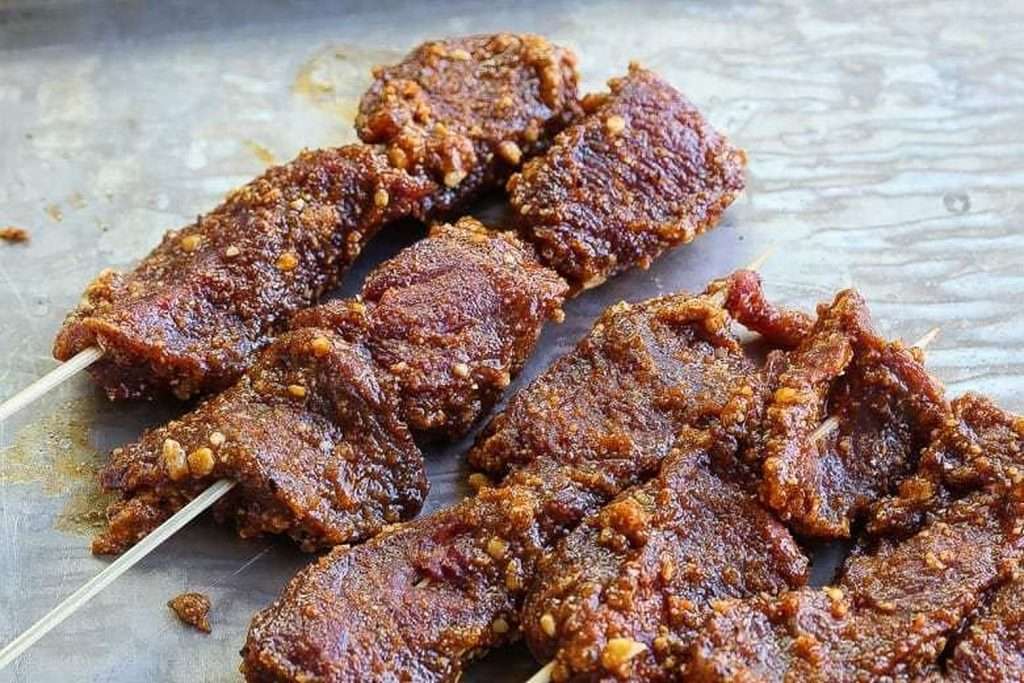
Suya is essentially skewered meat, predominantly beef and Cow, though chicken or fish variants aren’t uncommon. But calling Suya just skewered meat would be an understatement of its complex flavor profile.
The magic of Suya lies in its preparation. Before it hits the grill, the meat is marinated in a dry spice rub called ‘Yaji’, a flavorful concoction of peanuts, ginger, paprika, onion powder, and other ingredients. The use of Yaji sets Suya apart from other grilled meats you might encounter globally.
This specially prepared spice blend seeps into the meat, infusing it with a depth of flavor that is rich, spicy, and slightly smoky. The peanut component of Yaji gives Suya a distinctive nutty undertone that is irresistible.
Suya vendors, known as ‘Mai Suya’, artfully thread the spiced meat onto skewers and grill them over open flames. The result is a tender, succulent skewer of meat with a crispy, spice-infused exterior.
It’s typically served with fresh slices of onions, tomatoes, or cabbage, and sometimes an extra sprinkle of Yaji spice for those who like it extra hot.
Tagine – Morocco (Northern Africa)

Tagine refers both to the conical earthenware pot and the succulent stew that’s slow-cooked within it.
In the bustling street food markets of Marrakech, Fez, or Casablanca, you’ll see countless tagine pots steaming away, with their uniquely shaped lids acting as the perfect symbol of Moroccan culinary traditions.
The magic of a Tagine lies in its method of preparation and its variety. A medley of meats – often lamb, beef, or chicken – gets slow-cooked with a variety of vegetables, legumes, and Moroccan spices, creating a tender and intensely flavored stew.
The pot’s conical shape aids in the slow-cooking process, allowing the steam to rise, condense, and drip back onto the simmering stew, keeping the meat moist and the flavors well-rounded.
Savoring a Tagine is an immersive experience that transcends the boundary of taste. Each bite envelops your palate with a burst of flavors, reflecting the diverse influences that have shaped Moroccan cuisine over centuries.
The slow-cooking process infuses every morsel with the essence of the spices, offering a dish that’s both comforting and indulgent.
Final Thought
As a food enthusiast or a traveler, these popular African street foods offer a tantalizing adventure for your taste buds, adding depth to your African exploration.
So, the next time you find yourself on this diverse continent, remember to find time to enjoy any of these street foods. Your African adventure won’t be complete without it.

